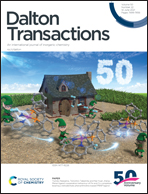Bis-(1,2,4-triazin-3-yl) ligand structure driven selectivity reversal between Am3+ and Cm3+: solvent extraction and DFT studies†
Abstract
Selectivity between Am3+ and Cm3+ was investigated after their aqueous complexation with three structurally tailored hydrophilic bis-(1,2,4-triazin-3-yl) ligands followed by their extraction with N,N,N′N′-tetraoctyl diglycolamide (TODGA) dissolved in an ionic liquid (C4mim·Tf2N). The three hydrophilic ligands used were SO3PhBTP, SO3PhBTBP, and SO3PhBTPhen. It was evident from the solvent extraction studies that SO3PhBTP formed a stronger complex with Cm3+ than with Am3+, but SO3PhBTPhen showed better complexation ability for Am3+ than for Cm3+, and SO3PhBTBP showed no selectivity for the two actinide ions. DFT calculations indicated that the coordinating ‘N’ atoms in BTP were more co-planar in the complex and this co-planarity was higher in the Cm3+ complex as compared to that in Am3+. In the case of BTBP and BTPhen ligands, on the other hand, the co-planarity was more pronounced in the Am3+ complexes. Mayer's bond order calculations of M–N bonds in the complexes also indicated a reversal of the complexation ability of the BTP and BTPhen ligands for Am3+ and Cm3+. Calculations of the complexation energies further supported the higher selectivity of the BTP ligand for Am3+ by −52.0 kJ mol−1, and better selectivity of the BTPhen ligand for Cm3+ by −24.7 kJ mol−1.



 Please wait while we load your content...
Please wait while we load your content...